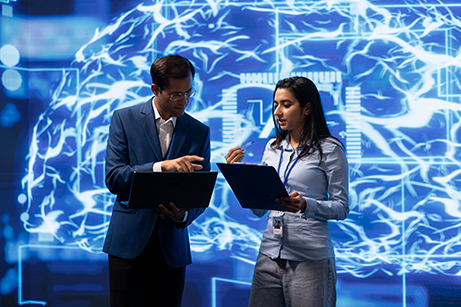AIMC Topic: Nerve Net
Clear Filters Showing 391 to 400 of 553 articles
Elimination of spiral waves in a locally connected chaotic neural network by a dynamic phase space constraint.
Neural networks : the official journal of the International Neural Network Society
Jan 16, 2017
In this study, a method is proposed that eliminates spiral waves in a locally connected chaotic neural network (CNN) under some simplified conditions, using a dynamic phase space constraint (DPSC) as a control method. In this method, a control signal...
Dendritic trafficking faces physiologically critical speed-precision tradeoffs.
eLife
Dec 30, 2016
Nervous system function requires intracellular transport of channels, receptors, mRNAs, and other cargo throughout complex neuronal morphologies. Local signals such as synaptic input can regulate cargo trafficking, motivating the leading conceptual m...
Comparison of Classifier Architectures for Online Neural Spike Sorting.
IEEE transactions on neural systems and rehabilitation engineering : a publication of the IEEE Engineering in Medicine and Biology Society
Dec 19, 2016
High-density, intracranial recordings from micro-electrode arrays need to undergo Spike Sorting in order to associate the recorded neuronal spikes to particular neurons. This involves spike detection, feature extraction, and classification. To reduce...
Metrics of brain network architecture capture the impact of disease in children with epilepsy.
NeuroImage. Clinical
Dec 12, 2016
BACKGROUND AND OBJECTIVE: Epilepsy is associated with alterations in the structural framework of the cerebral network. The aim of this study was to measure the potential of global metrics of network architecture derived from resting state functional ...
Automated selection of brain regions for real-time fMRI brain-computer interfaces.
Journal of neural engineering
Nov 30, 2016
OBJECTIVE: Brain-computer interfaces (BCIs) implemented with real-time functional magnetic resonance imaging (rt-fMRI) use fMRI time-courses from predefined regions of interest (ROIs). To reach best performances, localizer experiments and on-site exp...
Female
Reproducibility of Results
Adult
Computer Systems
Magnetic Resonance Imaging
Sensitivity and Specificity
Male
Humans
Visual Perception
Visual Cortex
Word Processing
Brain-Computer Interfaces
Unsupervised Machine Learning
Task Performance and Analysis
Nerve Net
Brain Mapping
Principal Component Analysis
Anti-correlations in the degree distribution increase stimulus detection performance in noisy spiking neural networks.
Journal of computational neuroscience
Nov 4, 2016
Neuronal circuits in the rodent barrel cortex are characterized by stable low firing rates. However, recent experiments show that short spike trains elicited by electrical stimulation in single neurons can induce behavioral responses. Hence, the unde...
Unsupervised Learning in an Ensemble of Spiking Neural Networks Mediated by ITDP.
PLoS computational biology
Oct 19, 2016
We propose a biologically plausible architecture for unsupervised ensemble learning in a population of spiking neural network classifiers. A mixture of experts type organisation is shown to be effective, with the individual classifier outputs combine...
Hopf Bifurcations in Directed Acyclic Networks of Linearly Coupled Hindmarsh-Rose Systems.
Acta biotheoretica
Oct 3, 2016
This paper addresses the existence of Hopf bifurcations in a directed acyclic network of neurons, each of them being modeled by a Hindmarsh-Rose (HR) neuronal model. The bifurcation parameter is the small parameter corresponding to the ratio of time ...
Hodge Decomposition of Information Flow on Small-World Networks.
Frontiers in neural circuits
Sep 28, 2016
We investigate the influence of the small-world topology on the composition of information flow on networks. By appealing to the combinatorial Hodge theory, we decompose information flow generated by random threshold networks on the Watts-Strogatz mo...
Spike-timing-dependent plasticity enhanced synchronization transitions induced by autapses in adaptive Newman-Watts neuronal networks.
Bio Systems
Sep 22, 2016
In this paper, we numerically study the effect of spike-timing-dependent plasticity (STDP) on synchronization transitions induced by autaptic activity in adaptive Newman-Watts Hodgkin-Huxley neuron networks. It is found that synchronization transitio...
Popular Topics
- Machine Learning 31137
- Neural Networks, Computer 29769
- Algorithms 26908
- Deep Learning 26418
- Artificial Intelligence 24354
- Robotics 13322
- Image Processing, Computer-Assisted 9552
- Retrospective Studies 9136
- Magnetic Resonance Imaging 6198
- Reproducibility of Results 5602
- Tomography, X-Ray Computed 4778
- Support Vector Machine 4695
- Computational Biology 4246
- Brain 4056
- Computer Simulation 3887
Recent Journals
- Scientific reports 6082
- Sensors (Basel, Switzerland) 4794
- PloS one 4044
- Neural networks : the official journal of the International Neural Network Society 2930
- Computational intelligence and neuroscience 1931
- Computers in biology and medicine 1868
- Annual International Conference of the IEEE Engineering in Medicine and Biology Society. IEEE Engineering in Medicine and Biology Society. Annual International Conference 1686
- Studies in health technology and informatics 1278
- IEEE journal of biomedical and health informatics 1137
- Journal of chemical information and modeling 1006
- Nature communications 959
- Computer methods and programs in biomedicine 883
- Bioinformatics (Oxford, England) 862
- Briefings in bioinformatics 853
- IEEE transactions on neural networks and learning systems 829
